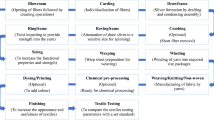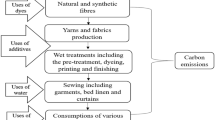Abstract
The textile industry is one of the critical industries that fulfils one of the fundamental requirements of human beings and, subsequently, becomes an unavoidable part of human life. Furthermore, the consumption of textile products is increasing rapidly over time, both locally and globally, due to population growth. The increased consumption of textile products has been a concern regarding both increased textile waste streams and environmental impacts. It is because of harmful chemicals and high water and energy consumption. Due to the widespread use of non-biodegradable packaging materials, this industry produces significant volumes of wastewater, sludge, gaseous waste, fabric waste, yarn waste, and fiber waste. The manufacture of textiles may be well controlled while producing the least amount of waste possible. Small quantities of resources used in the textile business, such as raw materials, water, energy, chemicals, and auxiliary materials, result in environmental, social, and economic sustainability. The kinds, origins, management practices, and advantages of textile waste are covered in this chapter. Recommendations are given for efficiently handling textile waste at the chapter's conclusion.
Access this chapter
Tax calculation will be finalised at checkout
Purchases are for personal use only
Similar content being viewed by others
References
Rasel MS, Das D, Khan MR (2020) Current scenario of textile sector in Bangladesh (2019); A Comprehensive Review. Int J Innov Stud Sci Eng Technol 4863(2019) 6(1):52–55. https://www.researchgate.net/publication/338750654_Current_Scenario_of_TextileSector_in_Bangladesh_2019_A_Comprehensive_Review
Remy N, Speelman E, Swartz S (2016) Style that’s sustainable: a new fast-fashion formula. McKinsey, New York
Särmäkari JJ (2021) Towards a more circular post-consumer textile waste management. https://lup.lub.lu.se/student-papers/search/publication/9058322. Accessed 23 July 2021
Ellen MacArthur Foundation (2017) A new textile economy; redesigning fashion future. https://www.ellenmacarthurfoundation.org/assets/downloads/publications/A-New-Textiles-Economy_Full-Report_Updated_1-12-17.pdf. Accessed 23 July 2021
Lellis B et al (2019) Effects of textile dyes on health and the environment and bioremediation potential of living organisms. Biotechnol Res Innov 3(2):275–290
Shamsuzzaman M, Abul Kashem M, Sayem ASM, Khan AM, Shamsuddin SM, Islam MM (2021) Quantifying environmental sustainability of denim garments washing factories through effluent analysis: a case study in Bangladesh. J Clean Prod 290:125740, pp 1–13. ISSN 0959–6526. https://doi.org/10.1016/j.jclepro.2020.125740
Periyasamy AP, Wiener J, Militky J (2017) Life-cycle assessment of denim. Book chapter: sustainability in denim, pp 83–101. https://doi.org/10.1016/B978-0-08-102043-2.00004-6
Effectiveness and Environmental Sustainability of Reactive Dyes for Their Structural Diversity (2022) Text Leather Rev 5:103–119. https://doi.org/10.31881/TLR.2022.02
Sustainability in fashion and textiles—values, design, production and consumption (2013) Management Environ Qual 24(4). https://doi.org/10.1108/meq.2013.08324daa.012
Wang Y (2010) Fiber and textile waste utilization. Waste Biomass Valoriz 1(1):135–143
Runnel A, Raihan K, Castle N, Oja D, Bhuiya H (2017) The undiscovered business potential of production leftovers within global fashion supply chains: creating a digitally enhanced circular economy insight from research among fabric and garment factories of China and Bangladesh, Reverse Resources. Reverse Resources. http://www.reverseresources.net/about/white-paper. Accessed 17 August 2018
Li X, Wang L, Ding X (2021) Textile supply chain waste management in China. J Clean Prod 289(125147):125147
Mathews B (2016) One third of all clothing “never sold”. Ecotextile News https://www.ecotextile.com/2016042122078/fashion-retail-news/one-third-of-all-clothing-never-sold.html
Payne A (2015) Open-and closed-loop recycling of textile and apparel products. In: Handbook of life cycle assessment (LCA) of textiles and clothing. Woodhead Publishing, pp 103–123
Daystar J, Chapman LL, Moore MM, Pires ST, Golden J (2019) Quantifying apparel consumer use behavior in six countries: addressing a data need in life cycle assessment modeling. J Text Appar Technol Manage 11(1)
Quantis (2018) Measuring fashion: environmental impact of the global apparel and footwear industries. https://quantis-intl.com/report/measuring-fashion-report/
Noman M, Batool SA, Chaudhary MN (2013) Economic and employment potential in textile waste management of Faisalabad. Waste Manag Res 31(5):485–493. https://doi.org/10.1177/0734242X12474711. Epub. PMID: 23439877
American Apparel and Footwear Association (2013) International trade commission, the U.S. Department of Commerce's Office of Textiles and Apparel, and the Council for Textile Recycling. Retrieved from https://www.epa.gov/facts-and-figures-about-materials-waste-and-recycling/textiles-material-specific-data?fbclid=IwAR2XuMvotfRZpsTO3ZTN4yQn0XMpwRVDY65-wV5ChpBx5AeKqiUPPivMkjA . Accessed 30 June 2021
Kabir SMF, Chakraborty S, Hoque SMA, Mathur K (2019) Sustainability assessment of Cotton-based textile wet processing. Cleanroom Technol 1(1):232–246. https://doi.org/10.3390/cleantechnol1010016
Cleaner Environmental Systems, Volume 4, 2022, 100070. https://doi.org/10.1016/j.cesys.2022.100070
Khairul Akter MM, Haq UN, Islam MM, Uddin MA Textile-apparel manufacturing and material waste management in the circular economy: a conceptual model to achieve sustainable development goal (SDG) 12 for Bangladesh
Shahriar Shams JN, Sahu SM, Shamimur R, Ahsan A (2017) Sustainable waste management policy in Bangladesh for reduction of greenhouse gases. Sustain Cities Soc 33. ISSN 18–26 2210 6707. https://doi.org/10.1016/j.scs.2017.05.008
Cleaner Environmental Systems (2022) Vol 4, 100070, ISSN 2666–7894 https://doi.org/10.1016/j.cesys.2022.100070
Muthu SS et al (2012) Carbon footprint reduction in the textile process chain: recycling of textile materials. Fibers Polym 13(8):1065–1070
Pensupa N, Leu SY, Hu Y, Du C, Liu H, Jing H, Wang H, Lin CSK (2017) Recent trends in sustainable textile waste recycling methods: current situation and future prospects. Chem Chem Technol Waste Valoriz 189–228
Reserve Resources (2017) White paper: digitally enhanced circular economy within global fashion supply chains. https://reverseresources.net/news/white-paper-by-rr. Accessed 30 June 2021
Zonatti WF, Baruque-Ramos J, Duleba W (2016) Brazilian scope of management and recycling of textile wastes. In: Natural Fibres: advances in science and technology towards industrial applications. Springer, Dordrecht, pp 429–439
Haule LV, Carr CM, Rigout M (2016) Preparation and physical properties of regenerated cellulose fibres from cotton waste garments. J Clean Prod 112:4445–4451
Zamani B (2014) Towards understanding sustainable textile waste management: environmental impacts and social indicators. Chalmers Tekniska Hogskola (Sweden)
Strähle J, Philipsen F (2017) Closed-loop production: a literature review. Green Fash Retail, pp 27–47
Patagonia (2017) Closing the loop—a report on patagonia’s common threads garment recycling program. https://www.patagonia.com/stories/closing-the-loop-a-report-on-patagonias-common-threads-garment-recycling-program/story-19961.html. Accessed 30 June 2021
Oliveux G, Dandy LO, Leeke GA (2015) Current status of recycling of fibre reinforced polymers: review of technologies, reuse and resulting properties. Progress Mater Sci 72:61–99
Miranda R et al (2007) Pyrolysis of textile wastes. J Anal Appl Pyrolysis 80(2):489–495
Nahil MA, Williams PT (2010) Activated carbons from acrylic textile waste. J Anal Appl Pyrolysis 89(1):51–59
Wanassi B, Azzouz B, Hassen MB (2016) Value-added waste cotton yarn: optimization of recycling process and spinning of reclaimed fibers. Ind Crops Prod 87:27–32
Rouf A, Rasel S, Khalil E (2015) Investigation of different washing effects on physical and mechanical properties of cotton knitted garments. J Text Sci Technol 01:101–109. https://doi.org/10.4236/jtst.2015.13011
Abdul Awal Z, Shamsuzzaman M, Das D (2021) Impact of laser intensities at various DPI and pixel time on the properties of denim garments. J Adv Res Mater Sci 77(1):1–13. https://doi.org/10.37934/arms.77.1.113
Hossain A (2019) Waste water production in fabric processing in Bangladesh. J Nat Soc Sci 8(3):558–563
Muthukumarana TT, Karunathilake HP, Punchihewa HKG, Manthilake MMID, Hewage KN (2018) Life cycle environmental impacts of the apparel industry in Sri Lanka: analysis of the energy sources. J Clean Prod 172:1346–1357
Babu B, Parande A, Raghu S, Kumar T (2007) Cotton textile processing: waste generation and effluent treatment. J Cotton Sci 11:141–153. http://journal.cotton.org
Guide for Assessment of Effluent Treatment Plants’ (2008) Department of environment. Ministry of Environment and Forest, Bangladesh, pp 1–79
Sivaramakrishnan CN (2010) Effluent standards. Colourage 57(2):76–77. https://doi.org/10.1007/1-4020-4494-1_103
Erc (2020) wastewater treatment chemical vs. biological processes. https://www.ercofusa.com/blog/wastewater-treatment-chemical-vs-biological-process/. Accessed 30 June 2020
Buscio V (2017) 9-chemicals and effluent treatment in indigo denim processes. Sustain Denim. Elsevier Ltd, pp 235–255. https://doi.org/10.1016/B978-0-08-102043-2.00009-5
Boralkar DDB (2004) Guidelines for operation & maintenance of effluent treatment plants. Maharashtra Pollut Control Board 1–36
Life (2007) Textile waste minimisation alternatives for waste volume reduction in the textile sector. Life-Environ Program: Eur Comm 8
Coskun G, Basaran FN (2019) Post-consumer textile waste minimization: a review. J Strategic Res Soc Sci 5(1):1–18. https://doi.org/10.26579/josress-5.1.1
Hossain L, Khan MS (2020) Water footprint management for sustainable growth in the Bangladesh apparel sector. Water 12(2760):1–33. https://doi.org/10.3390/w12102760
Nimkar I (2018) Sustainable chemistry: a solution to the textile industry in a developing world. Curr Opin Green Sustain Chem 9:13–17. https://doi.org/10.1016/j.cogsc.2017.11.002
Fayez A, Islam MS, Islam MS, Hasnat MA (2017) Energy consumption and estimation of greenhouse gas emission from garmentand textile industries in Bangladesh: a case study on Dhaka City. Acad J Environ Sci 5(4):065–075. https://doi.org/10.15413/ajes.2017.0102
Wu JX, Li L (2020) Fashion industry—an itinerary between feelings and technology. Sustainability Initiatives in the Fashion Industry. In: Fashion industry: an itinerary between feelings and technology, pp 1–18. https://doi.org/10.5772/intechopen.87062
Sajn N (2019) Environmental impact of the textile and clothing industry: what consumers need to know. Bruss Eur Parliamentary Res Serv. https://www.europarl.europa.eu/RegData/etudes/BRIE/2019/633143/EPRS_BRI(2019)633143_EN.pdf
Shenxun Y (2012) Prevention of waste from textile in Sweden. http://kth.diva-portal.org/smash/record.jsf?pid=diva2:504875. Accessed 30 June 2020
Author information
Authors and Affiliations
Corresponding author
Editor information
Editors and Affiliations
Rights and permissions
Copyright information
© 2023 The Author(s), under exclusive license to Springer Nature Singapore Pte Ltd.
About this chapter
Cite this chapter
Shamsuzzaman, M. et al. (2023). Waste Management in Textile Industry. In: Rahman, M.M., Mashud, M., Rahman, M.M. (eds) Advanced Technology in Textiles. Textile Science and Clothing Technology. Springer, Singapore. https://doi.org/10.1007/978-981-99-2142-3_10
Download citation
DOI: https://doi.org/10.1007/978-981-99-2142-3_10
Published:
Publisher Name: Springer, Singapore
Print ISBN: 978-981-99-2141-6
Online ISBN: 978-981-99-2142-3
eBook Packages: Chemistry and Materials ScienceChemistry and Material Science (R0)




